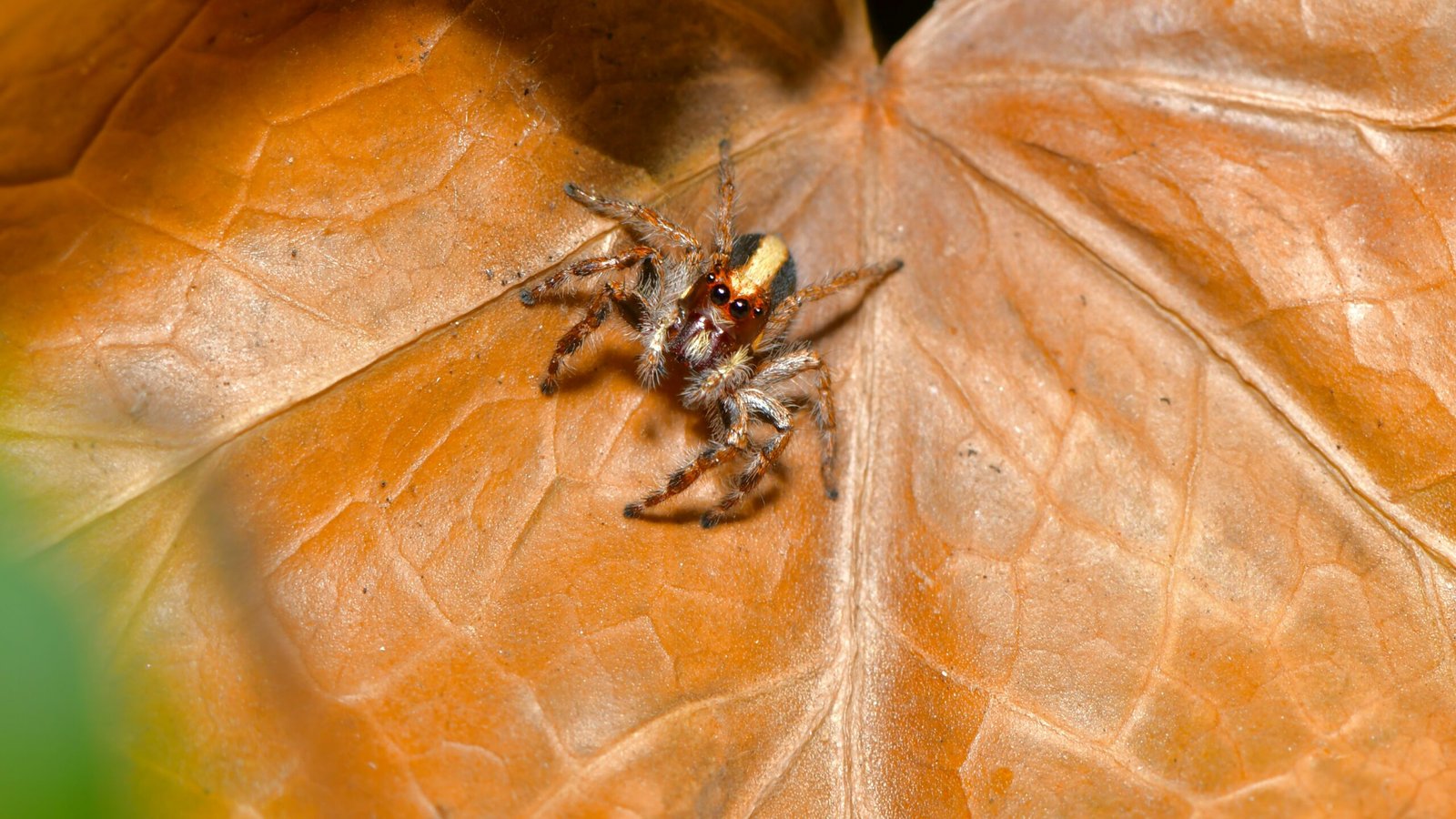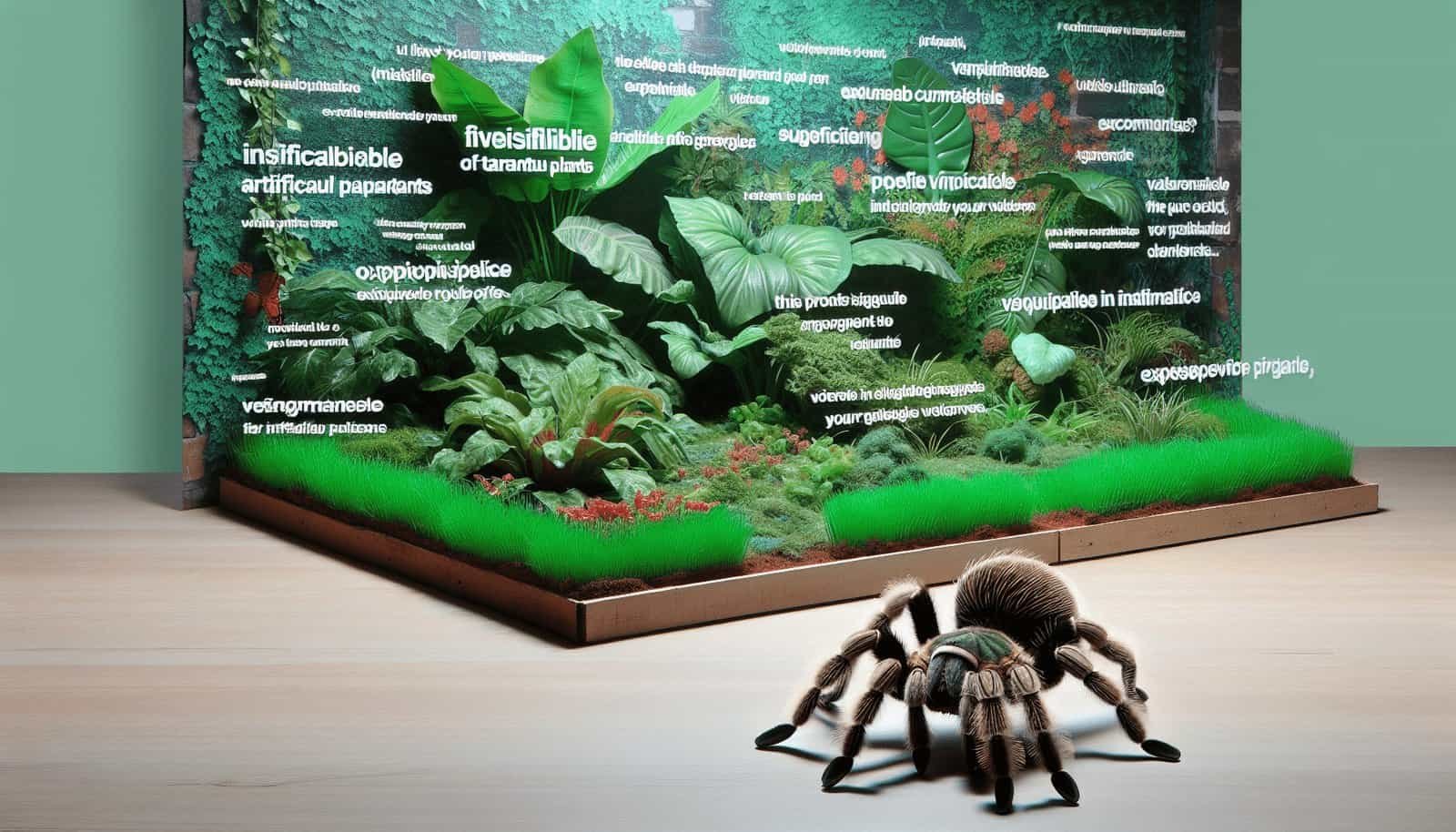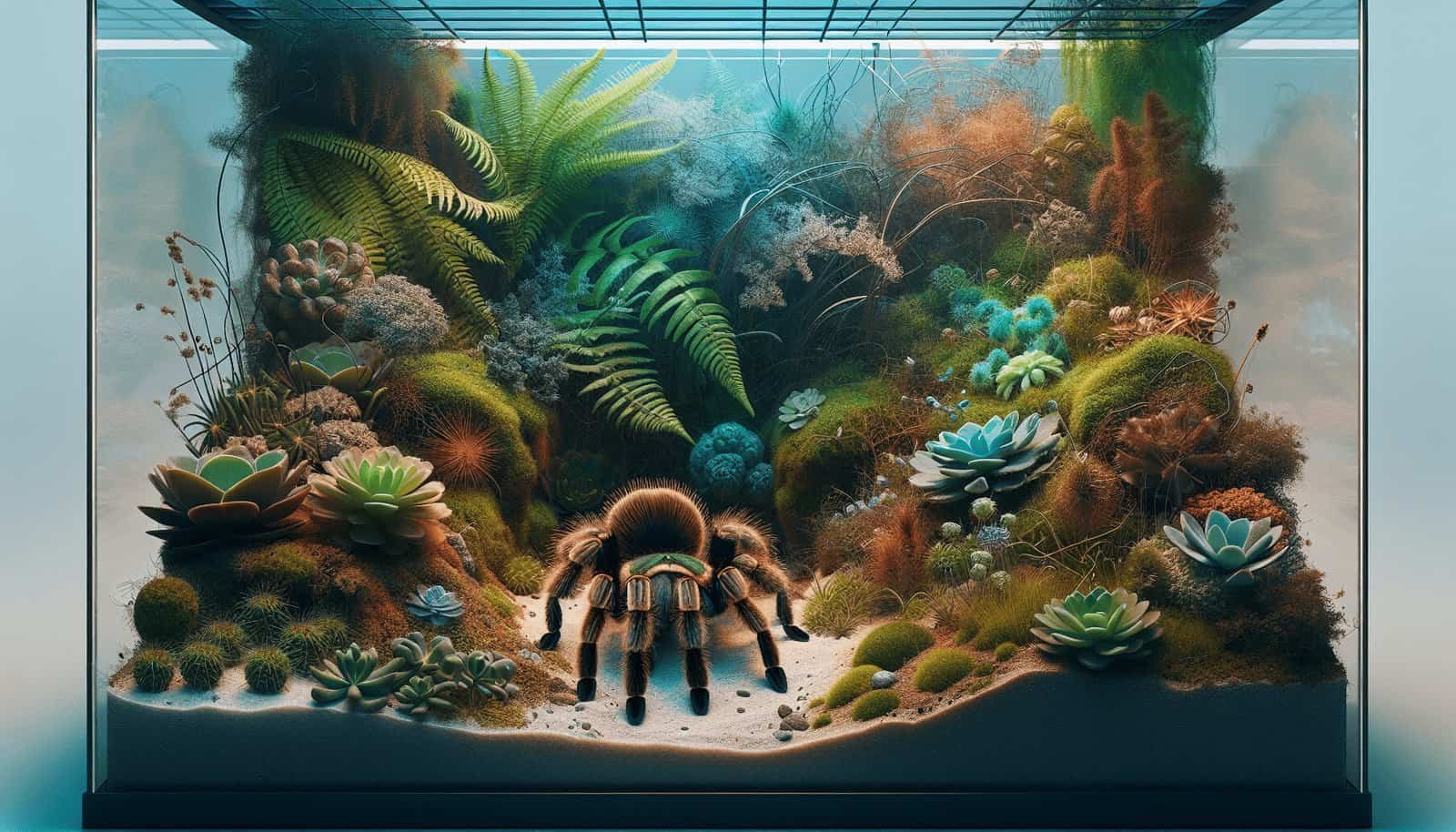Are you a tarantula enthusiast who wants to create a captivating and natural-looking habitat for your eight-legged friend? Well, you might be wondering if it’s possible to keep tarantulas in enclosures with artificial plants. In this article, we will explore whether or not tarantulas can thrive in a habitat adorned with fake foliage. So, let’s dive into this intriguing question and discover the potential benefits and considerations of incorporating artificial plants into your tarantula enclosure.

Benefits of Keeping Tarantulas in Enclosures with Artificial Plants
Enhanced Aesthetics
Keeping tarantulas in enclosures with artificial plants offers numerous benefits, the first being enhanced aesthetics. By incorporating artificial plants into the enclosure, you can create a visually appealing and natural-looking habitat for your tarantula. The vibrant colors, realistic textures, and lifelike foliage of artificial plants can transform a plain enclosure into a miniature tropical paradise. Not only will you enjoy the beautiful display, but your tarantula will also benefit from a visually stimulating environment that resembles its natural habitat.
Simulation of Natural Habitat
Another significant advantage of using artificial plants in tarantula enclosures is the ability to simulate their natural habitat. Tarantulas are native to various regions worldwide, each with its own distinct vegetation. By carefully selecting artificial plants that resemble the foliage found in your tarantula’s natural habitat, you can create an environment that mimics its native surroundings. This helps to promote a sense of familiarity and comfort for your tarantula, leading to reduced stress levels and enhanced overall well-being.
Ease of Maintenance
Keeping tarantulas in enclosures with artificial plants also offers the benefit of ease of maintenance. Unlike live plants, which require regular watering, pruning, and monitoring for pests, artificial plants are low-maintenance. You won’t have to worry about watering schedules or providing the necessary sunlight for plant growth. Additionally, artificial plants do not shed leaves, eliminating the need for frequent cleaning and preventing potential harm to your tarantula. With artificial plants, you can enjoy a visually appealing habitat without the added hassle of plant care.
Choosing Suitable Artificial Plants for Tarantula Enclosures
Selecting Non-Toxic Plants
When selecting artificial plants for tarantula enclosures, it is crucial to choose non-toxic options. Tarantulas are sensitive creatures, and exposure to toxic substances can have severe consequences on their health and well-being. Ensure that the artificial plants you choose are free from any harmful chemicals or substances that could potentially harm your tarantula. Opt for plants that are specifically labeled as safe for use in pet enclosures to provide a safe environment for your tarantula to thrive in.
Considering Size and Texture
In addition to being non-toxic, it is essential to consider the size and texture of the artificial plants you select for your tarantula enclosure. Tarantulas are known to explore their surroundings and may come into contact with the plants. Choose plants that are appropriately sized for your tarantula’s enclosure, ensuring they do not obstruct movement or create potential hazards. Additionally, pay attention to the texture of the plants. Tarantulas may use their sensitive legs to touch and navigate their environment, so opt for plants with realistic textures that closely resemble those found in nature.
Opting for Durable Materials
Tarantulas can be curious creatures, sometimes investigating their surroundings by climbing on objects, including artificial plants. To ensure the longevity of your tarantula’s habitat and prevent any potential hazards, it is vital to opt for artificial plants made from durable materials. Look for plants that are constructed with high-quality materials that can withstand the occasional climbing or probing from your tarantula. By choosing durable options, you can create a safe and long-lasting habitat for your tarantula to enjoy.
Arrangement of Artificial Plants in Tarantula Enclosures
Creating Hiding Spots
Arranging artificial plants in a tarantula enclosure involves creating hiding spots for your spider. Tarantulas are natural burrowers and often seek shelter or create hiding spots where they can retreat to for privacy and security. Position the artificial plants in a way that provides ample opportunities for your tarantula to hide. By creating hiding spots, you give your tarantula a sense of security and mimic their natural behavior in the wild, resulting in a happier and less stressed spider.
Designing Climbing Structures
Tarantulas are skilled climbers, and providing them with opportunities to exhibit this natural behavior is vital for their well-being. Incorporate artificial plants that can double as climbing structures within the enclosure. Opt for plants with sturdy branches or foliage that can support the weight of your tarantula. By designing climbing structures, you encourage exercise and improve the overall liveliness of your tarantula.
Accounting for Tarantula Behavior
When arranging artificial plants in a tarantula enclosure, it is essential to consider the specific behavior of your tarantula species. Some tarantulas prefer to stay close to the ground, while others enjoy exploring higher areas. Understanding your tarantula’s behavior will help you determine the optimal placement of artificial plants within the enclosure. By catering to your tarantula’s natural inclinations, you can create an environment that meets their behavioral needs and enhances their overall quality of life.
Cleaning and Hygiene Practices
Regular Dusting and Wiping
To maintain a clean and hygienic environment for your tarantula, regular dusting and wiping of the artificial plants are necessary. Dust and debris can accumulate on the plant surfaces over time, potentially harboring harmful bacteria or parasites. Use a soft, dry cloth or brush to gently remove any visible dust or particles from the plants. Regular cleaning will not only keep the enclosure looking tidy but also contribute to the overall health and well-being of your tarantula.
Avoiding Accumulation of Debris
Alongside regular cleaning, it is crucial to prevent the accumulation of debris in your tarantula’s enclosure. Debris, such as dead insects or shed exoskeletons, can accumulate around the base of artificial plants and become a breeding ground for bacteria and pests. Regularly check the plants and the surrounding area for any debris and promptly remove it to maintain a clean and pest-free environment. By minimizing potential sources of contamination, you can prevent health issues and ensure the longevity of your tarantula’s enclosure.
Preventing Mold and Mildew
Moisture can create the perfect breeding ground for mold and mildew, which can be detrimental to your tarantula’s health. When cleaning the enclosure, pay attention to any areas where moisture may collect, such as the base of artificial plants. Ensure proper ventilation within the enclosure to minimize the risk of excessive humidity. If you notice any signs of mold or mildew, promptly remove and replace the affected artificial plants to prevent further contamination.

Monitoring Tarantula Interaction with Artificial Plants
Observing for Any Negative Reactions
While tarantulas generally tolerate artificial plants well, it is crucial to monitor their interaction for any signs of negative reactions. Some tarantulas may be more sensitive to changes in their environment and may exhibit signs of stress or discomfort when introduced to new elements, such as artificial plants. Observe your tarantula closely for any unusual behavior, such as increased aggression, excessive grooming, or a lack of appetite. If you notice any concerning reactions, consider removing the artificial plants or adjusting their placement to ensure the well-being of your tarantula.
Ensuring Plant Edges Are Safe
Tarantulas have delicate exoskeletons that can be easily damaged by sharp or rough edges. Before introducing artificial plants into the enclosure, carefully inspect each plant for any sharp or pointed edges that could potentially harm your tarantula. File down or remove any protruding or sharp parts to ensure the safety of your tarantula. Prioritizing the safety and well-being of your tarantula should always be the top priority when selecting and arranging artificial plants in their enclosure.
Inspecting for Signs of Damage
Regularly inspect your tarantula’s enclosure for any signs of damage to the artificial plants. Since tarantulas may interact with the plants by climbing or probing, there is a possibility of wear and tear over time. Check for loose leaves, broken stems, or any other signs of damage that could potentially pose a risk to your tarantula. Replace damaged artificial plants promptly to maintain a safe and visually appealing habitat for your tarantula.
Potential Risks and Precautions
Toxicity Inflicted by Artificial Plants
While selected non-toxic plants are generally safe for use in tarantula enclosures, it is essential to be aware of the potential risks. Some artificial plants may contain dyes, chemicals, or materials that could be toxic to tarantulas if ingested or came into contact with their sensitive exoskeleton. Always research the materials used in the artificial plants you choose and ensure they are safe for your tarantula. If unsure, consult with a veterinarian or tarantula expert to ensure the well-being of your spider.
Avoiding Sharp or Pointed Objects
When incorporating artificial plants into a tarantula enclosure, it is crucial to avoid sharp or pointed objects that could potentially harm your tarantula. Tarantulas can be surprisingly agile climbers and may inadvertently come into contact with sharp edges, risking injury. When selecting and arranging artificial plants, choose options with smooth edges and avoid any decorations or accessories that may have sharp or pointy parts. Your tarantula’s safety should always be the top priority in designing their habitat.
Preventing Entrapment
Tarantulas have unique body structures that allow them to maneuver through tight spaces and crevices. However, certain artificial plants may have small gaps or openings that could potentially trap your tarantula. During the selection process, opt for plants with solid structures and minimal gaps where your tarantula could become trapped. Additionally, regularly inspect the enclosure to ensure that no gaps have developed over time or due to wear and tear. By proactively addressing potential entrapment hazards, you can safeguard your tarantula’s well-being.

Alternatives to Artificial Plants for Tarantula Enclosures
Using Live Plants
While artificial plants offer many benefits, some tarantula keepers prefer to use live plants in their enclosures. Live plants can provide additional oxygenation, humidity regulation, and even a natural food source for some tarantula species. When considering live plants for your tarantula enclosure, research is essential. Ensure that the chosen plants are non-toxic to tarantulas and compatible with the specific habitat conditions required by your tarantula species. Live plants require more maintenance compared to artificial plants, but they can provide a more natural and dynamic environment for your tarantula.
Decorating with Natural Materials
Another alternative to artificial plants is decorating the tarantula enclosure with natural materials. This approach involves incorporating wood branches, rocks, and other natural elements to create a visually appealing and realistic habitat. Natural materials provide tactile stimulation for your tarantula and can be more easily replaced or adjusted to suit their needs. When using natural materials, ensure they have been cleaned and disinfected to prevent the introduction of unwanted pests or diseases to your tarantula’s enclosure.
Creating Artificial Landscapes
For those seeking a more creative and imaginative approach, creating artificial landscapes can be a rewarding alternative to using plants. This involves designing and crafting custom-made structures, caves, or landscapes that replicate elements of a tarantula’s natural habitat. Materials such as foam, silicone, and non-toxic paints can be used to construct intricate and visually stunning features. Artificial landscapes offer endless possibilities for customization and can be a great option for showcasing your artistic skills while providing a stimulating environment for your tarantula.
Considerations for Specific Tarantula Species
Researching Natural Habitat
When keeping tarantulas in enclosures with artificial plants, it is crucial to consider the specific natural habitat of your tarantula species. Researching the native environment of your tarantula will help you select artificial plants that closely resemble the vegetation found in their natural habitat. Whether your tarantula is native to tropical rainforests, arid deserts, or temperate grasslands, understanding their natural habitat will allow you to create a more accurate and enriched environment for their well-being.
Adapting Enclosure to Species Needs
Not all tarantulas have the same habitat requirements, and it is essential to adapt the enclosure accordingly. Some tarantulas prefer open spaces, while others thrive in densely vegetated areas. Consider the specific needs of your tarantula species and adjust the placement and arrangement of artificial plants accordingly. Providing appropriate hiding spots, climbing structures, and other environmental elements specific to your tarantula species will contribute to their overall health and contentment.
Consulting Tarantula Experts
If you are unsure about the specific requirements of your tarantula species, it is always beneficial to consult with tarantula experts. Experienced tarantula keepers, breeders, or even local exotic pet shops knowledgeable about tarantulas can provide valuable insights and advice specific to your tarantula species. They can guide you in selecting suitable artificial plants and assist in designing an enclosure that meets all of your tarantula’s needs. Seeking expert guidance ensures that you provide your tarantula with the best possible environment for their well-being.

Personal Experiences and Expert Opinions
Interviews with Tarantula Keepers
To gain a better understanding of the benefits and considerations of keeping tarantulas in enclosures with artificial plants, interviews with tarantula keepers can provide valuable insights. Speaking to experienced individuals who have successfully maintained tarantulas in such enclosures can offer firsthand experiences, tips, and advice. These interviews can shed light on the specific challenges and advantages they have encountered while incorporating artificial plants into their tarantula habitats.
Insights from Tarantula Breeders
Tarantula breeders are another valuable source of information when considering the use of artificial plants in tarantula enclosures. Breeders often have extensive knowledge about various tarantula species and their specific needs. Through their experiences, they can offer insights into the benefits and potential pitfalls of using artificial plants and provide recommendations based on the tarantulas they have bred and raised. By tapping into their expertise, you can make informed decisions when designing and maintaining your tarantula’s enclosure.
Case Studies of Successful Enclosures
Examining case studies of successful tarantula enclosures with artificial plants can provide inspiration and guidance. Online forums, community groups, or even published books may feature detailed accounts of enthusiasts who have documented their journey in creating and maintaining a thriving artificial plant-based habitat for their tarantulas. Analyzing these case studies allows you to understand the different approaches, techniques, and plant selections that have proven successful for other tarantula keepers. By drawing from their experiences, you can avoid common pitfalls and optimize the design of your own tarantula enclosure.
Conclusion
Balancing Aesthetics and Safety
In conclusion, keeping tarantulas in enclosures with artificial plants offers a multitude of benefits, including enhanced aesthetics, simulation of natural habitat, and ease of maintenance. However, it is essential to balance aesthetics with the safety and well-being of your tarantula. By selecting non-toxic plants, considering size and texture, and opting for durable materials, you can create a visually appealing habitat that prioritizes the safety of your tarantula.
Tailoring Enclosure to Tarantula’s Requirements
When designing the arrangement of artificial plants, it is crucial to cater to your tarantula’s specific needs. Creating hiding spots, designing climbing structures, and accounting for tarantula behavior are key factors in providing an enriched environment for your tarantula. Regular monitoring and cleaning practices will ensure the health and hygiene of the enclosure, while precautions against potential risks, such as toxicity or entrapment, should be taken into account.
Creativity in Design
While artificial plants are a popular choice for tarantula enclosures, options such as live plants or natural materials offer alternatives for customization and environmental stimulation. Researching the natural habitat of your tarantula species, adapting the enclosure to their needs, and consulting experts will help create a suitable environment for their well-being.
Incorporating artificial plants into tarantula enclosures requires careful consideration, but with proper planning and attention to detail, you can create a visually stunning and safe habitat for your beloved tarantula. By embracing creativity in design and tailoring the enclosure to your tarantula’s requirements, you will undoubtedly provide them with an environment that promotes their overall health, happiness, and natural behaviors.
